Athearn Trains 40-Foot Pfaudler Wood Milk Car
Published: 2024-06-01 - By: CNW400
Last updated on: 2024-07-01
Last updated on: 2024-07-01
visibility: Public - Headline
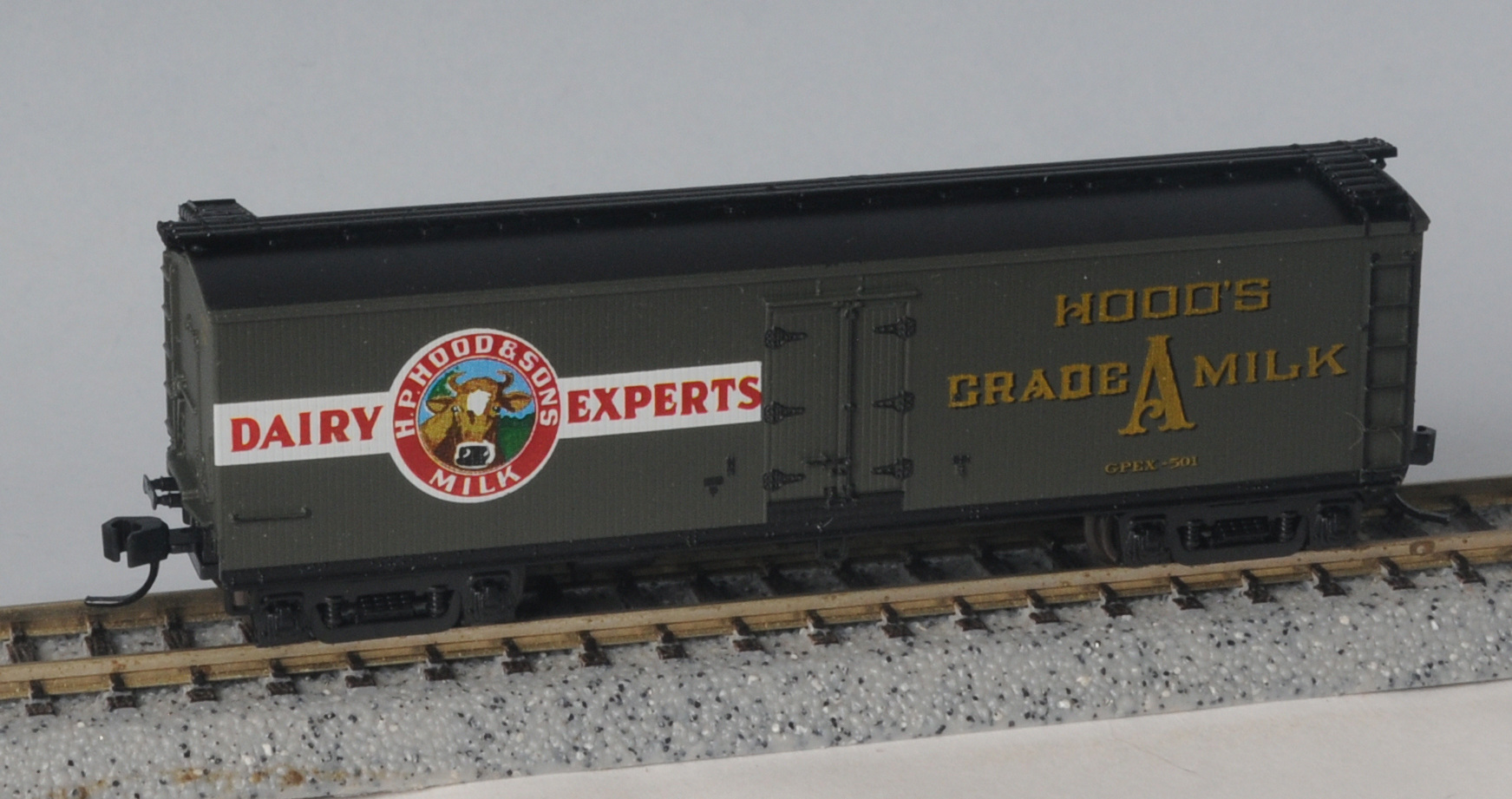
The Prototype
The dairy farmers of the early 1800s were driven to bolster their markets but were hit with the harsh challenges of delivering fresh milk from the far outlying country areas to the big city consumers. The highly perishable raw milk required dependable, quick transport with a means to keep the product at a cool temperature to prevent spoilage. With the American railroad system expanding their presence into new territories by the mid-1800s, the railroads realized the dairy farmer demanded daily, year-round service (cows do not take a day off) and provided a constant revenue stream.
At first, rural deliveries of raw milk were hauled in churns and loaded onto standard wooden boxcars. Then the traditional 10-gallon (40-quart) milk can was utilized – a cumbersome 27-pound when empty steel container that held 86 pounds of milk. These cans of milk were then placed in passenger train baggage cars as express service with other crates and packages. The milk cans either had blocks of ice placed on top or insulated blankets wrapped around them to regulate the temperature inside the container. The speedy passenger train provided the quick delivery times from collection station to processing plants that a freight train could not provide. Freight trains ran at a slower speed and the time dedicated to switching cars in yards would lead to spoiled product. This was still not the best option with melting ice damaging interior floors and the other parcels.

The early 1900s saw the introduction of specialized insulated wood cars to transport milk – double-sheathed with insulation between the interior and exterior walls, and floor racks that handled the runoff of water from ice placed on top of the cans. Ice bunkers were not necessary since the dairy product was aboard only for hours – not the days fruits and vegetables were carried inside contemporary refrigerator cars. Load restraints were used to restrict the shifting of cans with sliding doors for trackside platform clearance. Forty-foot cars were common with fifty-foot cars becoming popular later, expanding the limited amount of internal floor space available. High-speed trucks were used as these milk cars were head-end running on passenger trains (placed between the locomotive and passenger equipment) to make switching easier once its destination was reached.
But the railroads were still not satisfied – the handling of cans was extremely labor intensive. Thousands of cans, which were also prone to damage, had to be properly returned to the correct owners to be cleaned and sanitized between each use. The heavy 27-pounds cans accounted for literally tons of dead tare weight and car capacity space with their inability to be stacked. A typical 40-foot milk car was able to haul 300 cans – that is 8100 pounds…over four-tons of weight just for the steel storage cans.


Enter Caspar Pfaudler into the story – German brewmaster who in 1884 invented the process for lining steel tanks with glass for the beer industry. The Dickson Manufacturing Company constructed the first industrial glass-lined tank in 1887. The glass-lined tanks were easy to clean, corrosion resistant, and held non-stick properties.
The Boston and Maine Railroad was the first to use glass-lined tanks in 1910. Two 3000-gallon tanks were designed by Pfaudler Company and placed inside a traditional boxcar with a removable single-piece roof to repair or replace damaged tanks. The tanks were constructed so well that this design was later abandoned and changed to a conventional roof. The car body protected the tank valves, connections, and thermometer while providing additional insulation. In 1921, the Baltimore & Ohio Railroad further expanded the use of Pfaudler milk tanks rebuilding three express reefers with two 2500-gallon tanks per car.
In 1922, General American Car Company and the Pfaudler Company formed a partnership that saw hundreds of wooden, insulated milk cars built throughout the 1920s. The cars on the outside resembled standard 40-foot reefers -- double-sheathed with a steel fishbelly center sill on passenger train trucks. Steel support cradles held the tanks secure and slanted slightly toward the center of the car to make unloading easier via a pump or compressed air. A hinged manway gave access to the tank for cleaning after each trip. Brine coils precooled the tanks at the creamery to 38ºF. Although intended for trips of short duration, a test performed by Pfaudler Company shipped milk in their tanks from Wisconsin to Florida (a trip of 101 hours) with the temperature rising only one degree. An electric two-speed agitator stirred the load to keep a uniform temperature and keep the butterfat evenly distributed throughout the milk. Unique to General American milk cars was a sliding access door for the loading/unloading tank hose above the main four-foot doors to keep the interior clean and lessening the chance of contamination.

General American became the dominate milk tank car builder – leasing a large fleet of cars with the reporting marks GARE (General American Refrigerator Express). General American and Pfaudler Company created a subsidiary in 1932 to co-manage these milk cars -- General American-Pfaudler Corporation (GPEX). These milk cars were frequently painted Pullman green to match the heavy-weight passenger cars of the period and featured large graphics and/or lettering of the lessee or owner of the railcar. These ‘billboard” cars were banned by the Interstate Commerce Commission in 1934 with an effective date of 1937.
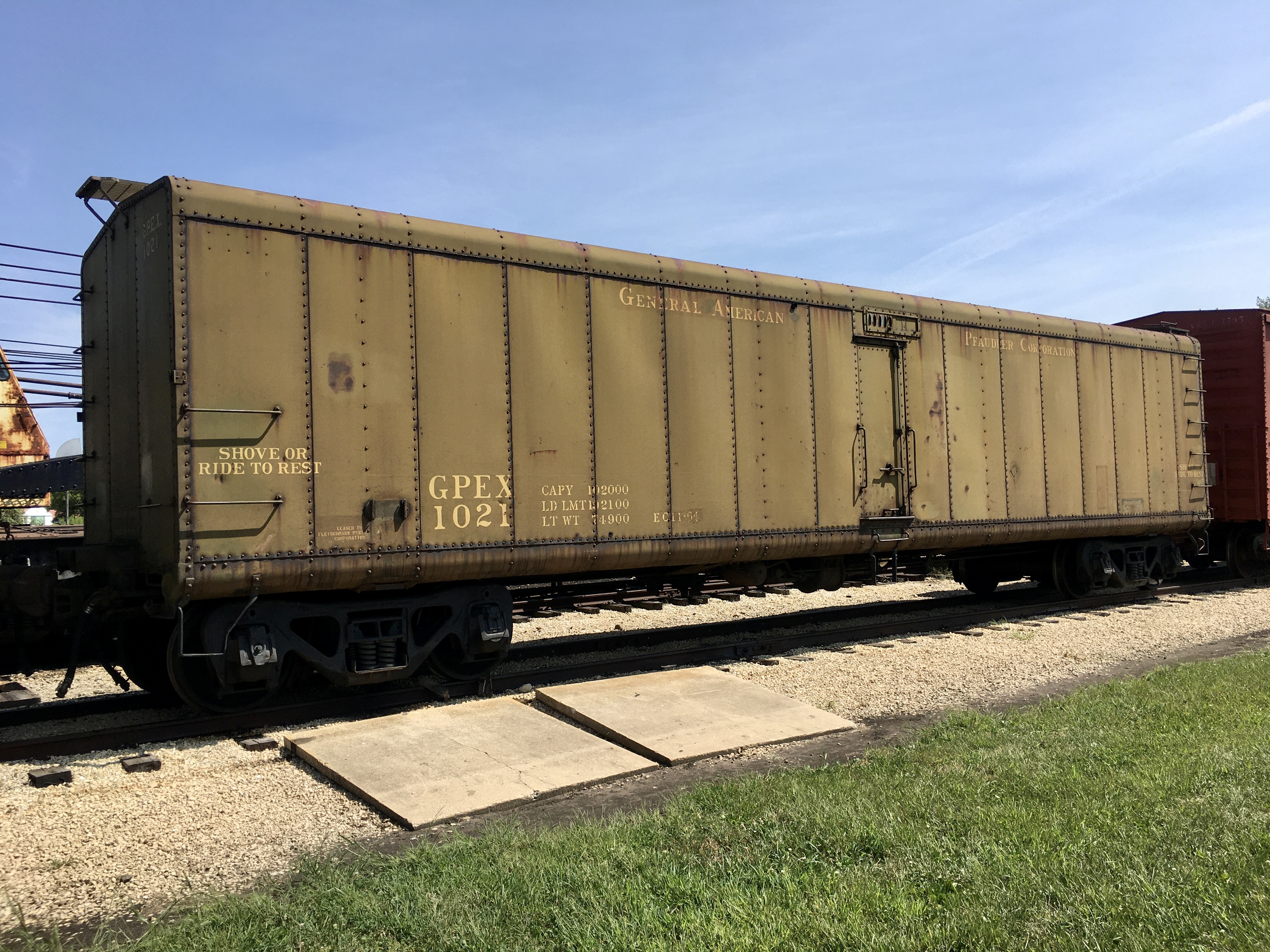
Coming out of The Great Depression during the late 1930s, railroad milk train traffic began to falter. Flat dairy sales during the Depression, paired with the decline of passenger train routes and trucks taking advantage of improved national roadways bought about the demise of dedicated special purpose milk trains. Trucks grew larger, could collect the milk stored at plants away for the tracks, and delivered to final consumers faster than trains could. Pfaudler tank milk cars were almost obsolete by the mid-1950s. Some processed dairy products continued to be hauled in standard refrigerator cars – such as butter, cheese, and dried milk.

Roads Names and Pricing
This is the 5th series release of N Scale Pfaudler tank milk cars from Athearn Trains – first introduced in 2007. This last collection was made available to the public in July 2023.- Alderney Dairy Company
- Chicago and North Western
- Merkle Dairy Company
- Pfaudler
- Reid Ice Cream
Three unique road numbers are available for each paint scheme with a suggested retail price of $29.99. My review includes observations for Athearn Trains ATH24037: Merkle Dairy Company Milk Car - GARE #742
The Model
The ready-to-run wooden milk car came packaged in a clear plastic jewel case with a slip-off cover and a two-piece plastic cradle to support the model. The jewel case was found nestled inside a yellow chipboard sleeve. The model information is clearly labeled on the end of the case and cardboard jacket for ease to locate when in storage. A thin plastic film was also wrapped around the car to protect the railcar from scuffmarks. No additional parts were found in the case.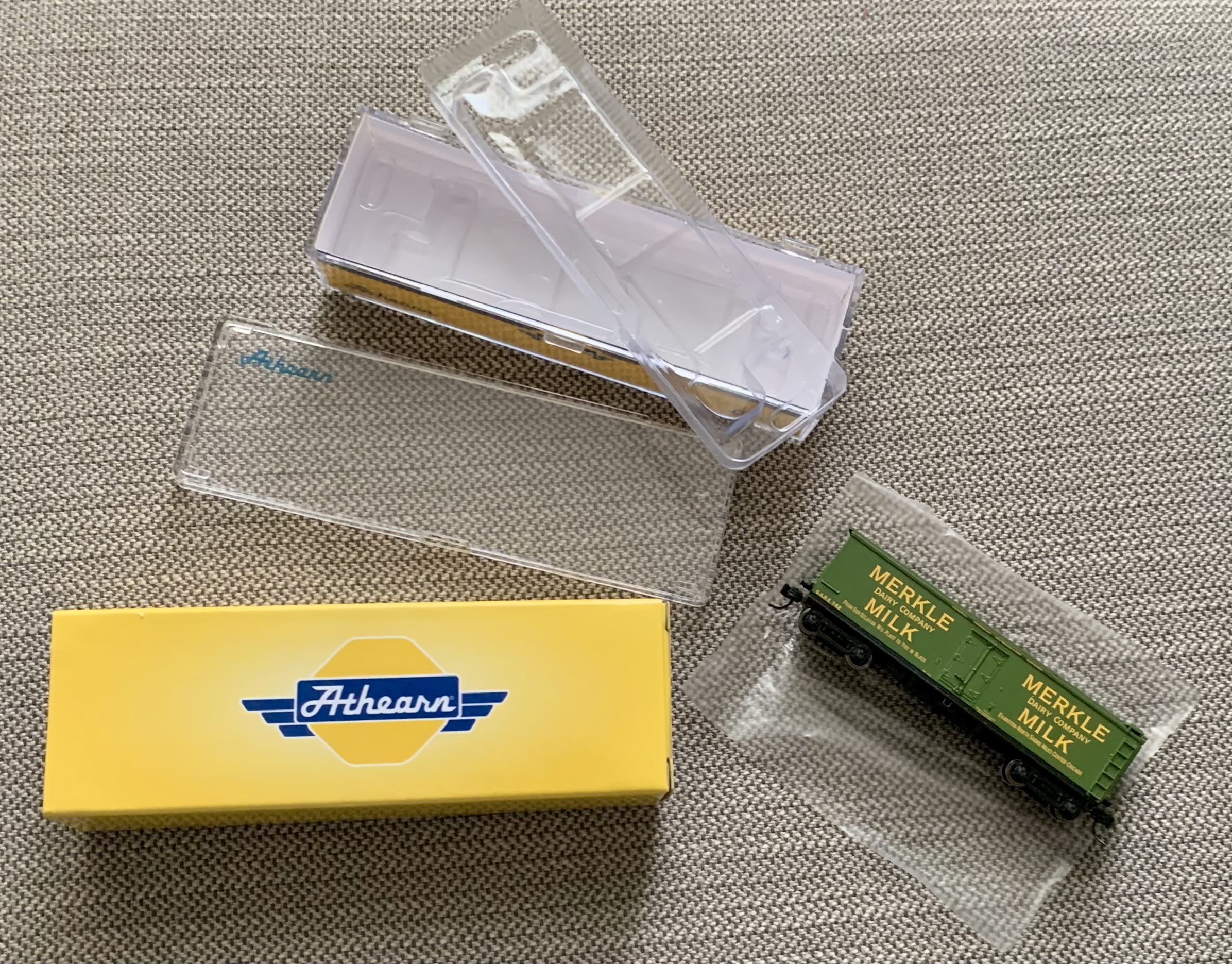
The paint job is clean and even along the injection-molded plastic body. The wooden milk car features a vertical board pattern with the typical smaller four or five-foot hinged doors to better control the amount of dirt and contamination inside the tank compartments. The car is painted Pullman green with black roof to match the heavyweight passenger cars it would be paired with during daily express routes. The molded side doors and side sills exhibit sharp detail work.
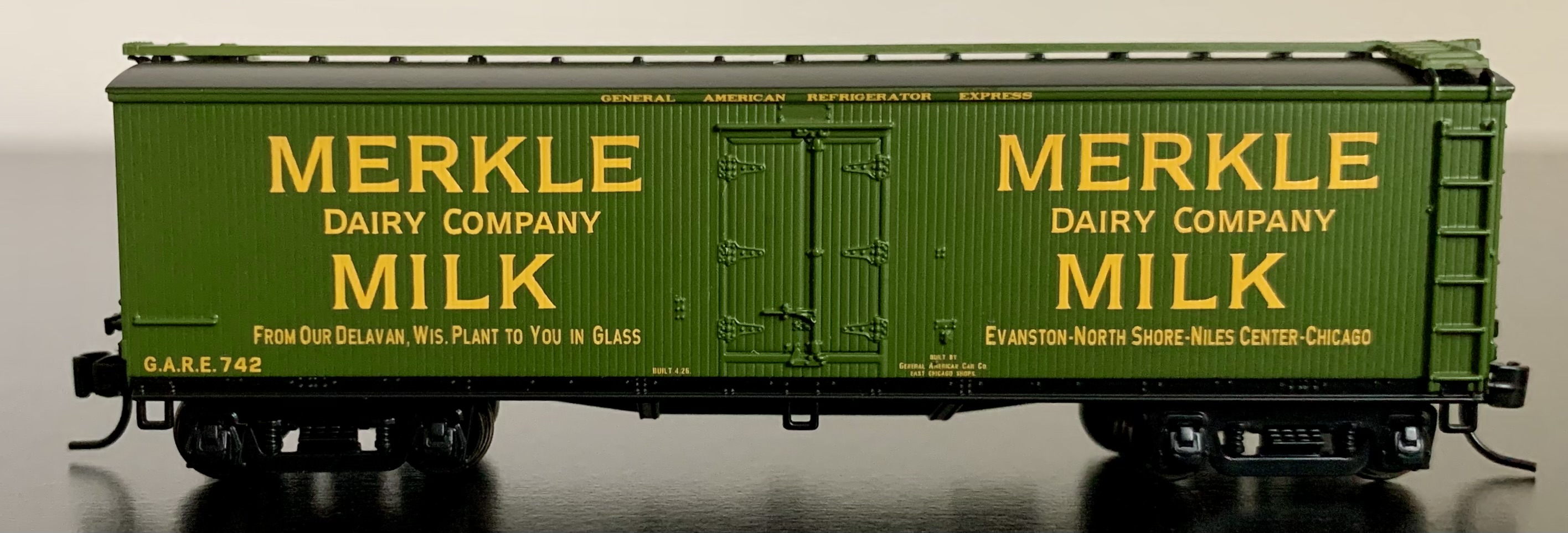
The Merkle Dairy Company Milk billboard style advertising is large and bold on both sides of the doors in a bright yellow color. The Merkle Dairy Company had a long history of existence – including one of the region’s largest plants in Evanston, Illinois. The Evanston plant had a tower constructed in the shape of a forty-foot-tall milk bottle…laying claim as the world’s biggest milk bottle. The General American Refrigerator Express name is neatly stamped right above the valve access panel door. The General American East Chicago Shop built car displays the correct early design stage single grab iron and full ladder configurations.
The Pfaudler milk cars were outfitted for head-service passenger traffic – thus constructed with air, steam, and signal lines with corner buffers. The Athearn model displays finely detailed molded end piping and brake chain details on both ends of the car. No need for a traditional brake wheel. The lettering is neat with the road marker and road number centered near the top of the milk car ends.
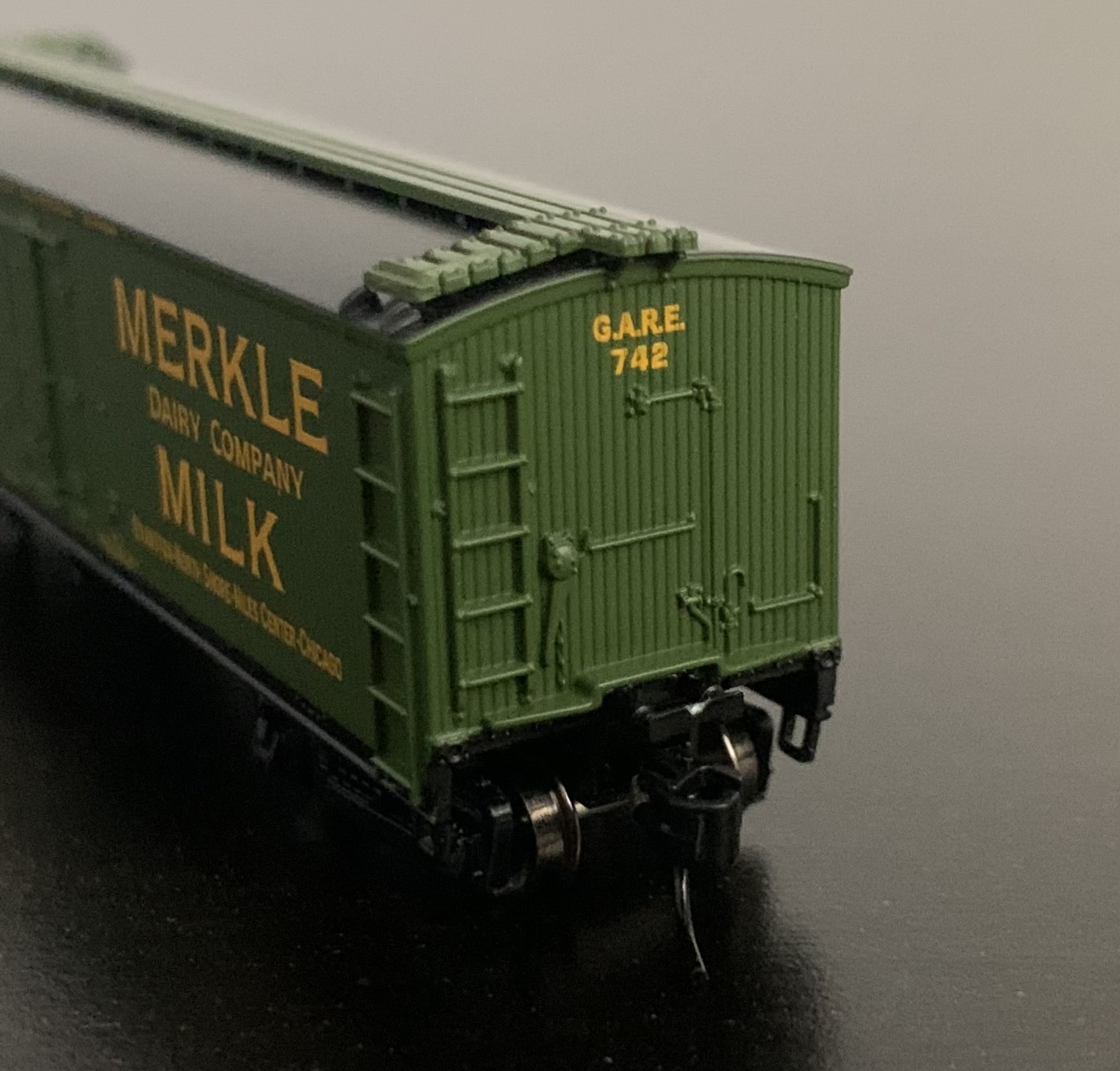
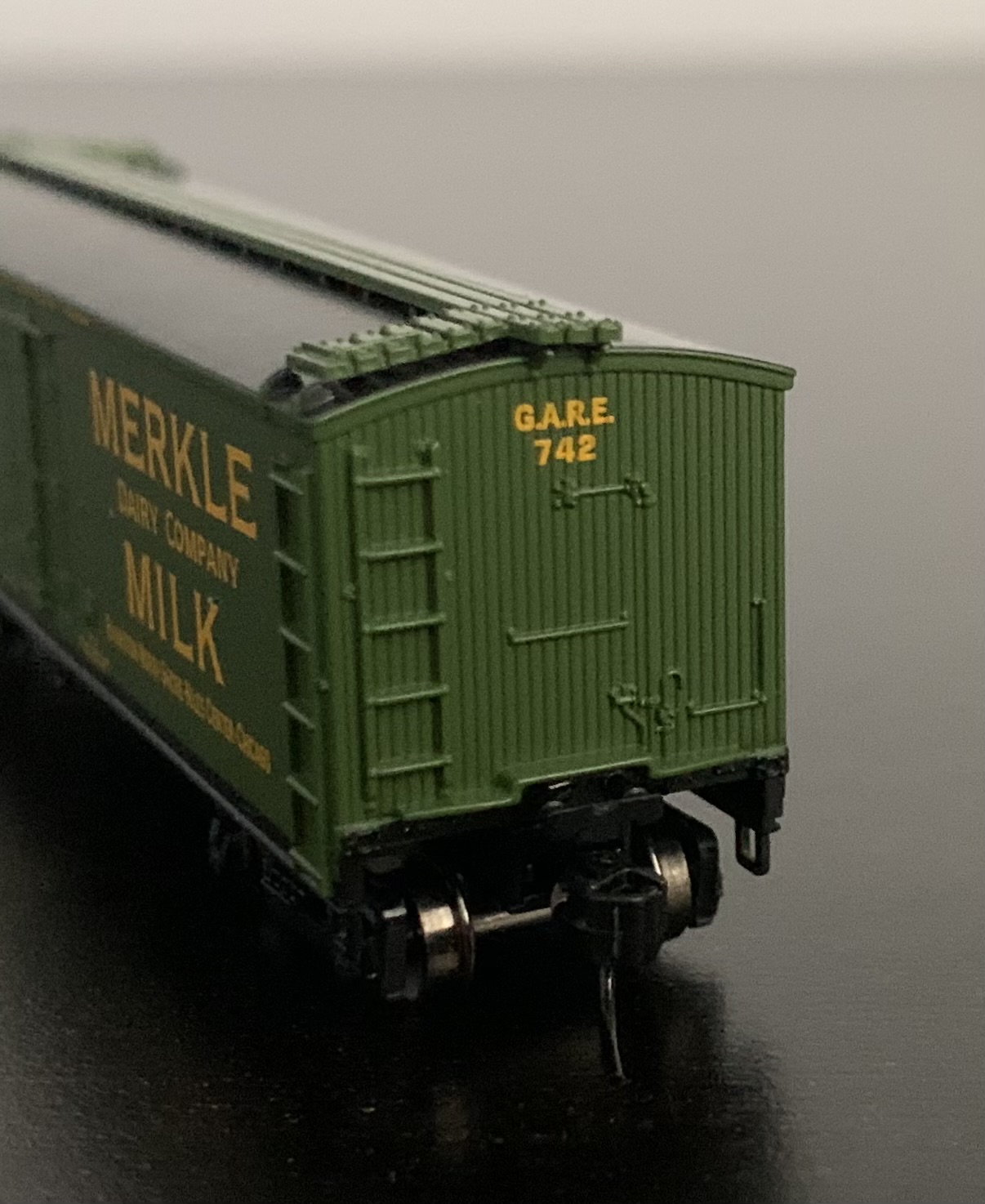
The top of the milk car features a black metal round one-piece roof design with an extended running board and lateral running boards at each end. The single roof section was originally applied in case of tank replacement or repair. Ice hatches were not necessary with the tanks keeping the milk cool – eliminating the expenses of both ice and labor.
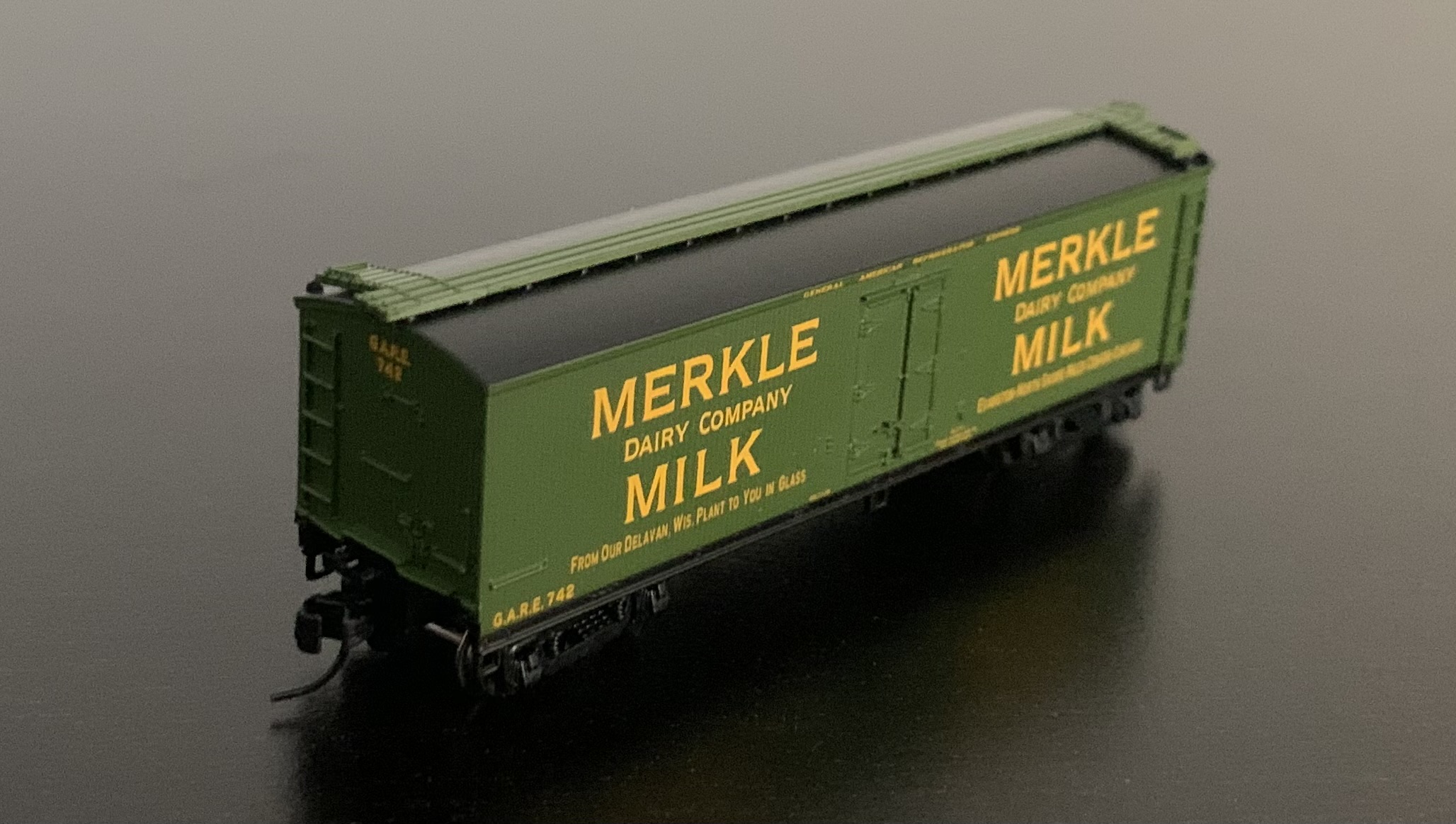
The black fishbelly underframe features a passenger car brake system arrangement with the brake cylinder, supplementary reservoir, and auxiliary reservoir. Both cross bearers show nice rivet detail. The boxcar is fitted with screw mounted high-speed Commonwealth trucks with blackened RP-25 machined metal wheels. Lastly, the model is equipped with proper height body mounted McHenry knuckle couplers.

The car measures 3 inches in length and weighs exactly 1.0 ounce, which is perfect according to the National Model Railroad Association (NMRA) recommendations (which are 0.97 - 1.0 ounce for this size car). I found it a solid runner while testing the car on Kato Unitrack with no issues around curves or through turnouts at slow and medium speeds. The recommended minimum operating radius is 11" for both Code 55 and 80 rails.
No crying about spilled milk here – Athearn faithfully produced an exceptional N scale early scheme Pfaudler milk car. Prototypical design with fun billboard paint schemes, fine molded details, metal wheels, and body mounted couplers. Excellent running railcar that needs zero modification – I have a milk train with a few of these cars hooked-up together and they look great on my transitional era layout. Spoil yourself and grab yourself a nice, cool Athearn Trains 40-Foot Pfaudler Wood Milk Car.
To View the Entire Collection of Athearn 40-Foot Wood Milk Cars: CLICK HERE
Photo Credits
Lee, Russell, photographer. (1940) Unloading cans of milk from early morning train. Montrose, Colorado. Montrose County United States Colorado Montrose, 1940. Sept. Retrieved from the Library of Congress. No known restrictions.Delano, Jack, photographer. (1941) Shoveling ice into a railroad carload of milk at the United Farmers' Cooperative Creamery, Sheldon Springs, Vermont. United States Vermont Sheldon Springs Franklin County, 1941. Sept. Retrieved from the Library of Congress. No known restrictions.
Delano, Jack, photographer. (1941) Farmer getting his empty milk cans back at the Burlington cooperative milk bottling plant. Burlington, Vermont. United States Vermont Chittenden County Burlington, 1941. Aug. Retrieved from the Library of Congress. No known restrictions.
Lee, R., photographer. (1941) Sterilizing milk cans at the Dairymen's Cooperative Creamery. Caldwell, Canyon County, Idaho. Caldwell United States Idaho Canyon County, 1941. June. Retrieved from the Library of Congress, No known restrictions.
Koltz, Scott, photographer. (2020) General American Pfaudler GPEX 1021- BMT Steel Milk Car, Union, Illinois. Delano, Jack, photographer. Milk truck in front of the New England Dairies in Enosburg Falls, Vermont. Sept. Photograph. Retrieved from the Library of Congress, No known restrictions.

